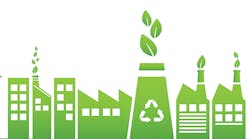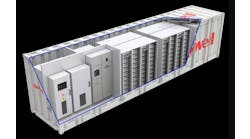This article is part of a series on industrial sustainability. Read more here.
Because as there's no one-size-fits-all sustainability solution, it's crucial for each user and organization to determine which combination of options will best suit the needs of their application, facility and local environment. Just as with all process automation and control projects, it's essential to evaluate the process, regardless of whether the goal is performance optimization, sustainability or both.
Aveva
"Most corporate sustainability initiatives include a broad variety of environmental, social and governmental (ESG) topics, but at Aveva, we think about the positive impact we can have through our customers as our ‘technology handprint.' Data and our software can help them transform beyond energy efficiency, accomplishing goals like decarbonizing, expanding recycling to a circular process that reduces waste throughout their plant's lifecycle, and making them more resilient, especially across their energy supply chain," says Lisa Wee, sustainability VP at Aveva. "Every customer is talking about sustainability. Previously, it was often a customer-facing program, but now it's become an industrial imperative, with accompanying regulations and the ability to provide long-term competitive advantages to those who can operate in low-carbon modes”.
Because Aveva's software can aid monitoring, control, asset performance and simulation, Wee reports it's been used to consolidate data points in several sustainability-related projects. These include querying about a million data points and balancing wind, solar and nuclear energy sources and subsea connections for sections of the U.K.'s national grids in England and Wales. These points are refreshed every few seconds, while software with integrated artificial intelligence (AI) seek patterns and insights. Likewise, Aveva worked with a digital backbone of more than 4,000 sensors on Henkel's laundry equipment to help achieve its climate targets, and eventually reduced its energy consumption by 16% and saved 8 million euros per year.
"Approximately 40% of greenhouse gas emissions today are produced by industry, so we need to help them decarbonize to achieve net-zero emissions, and limit global warning at 1.5 °C above pre-industrial levels as set out in the 2015 Paris agreement," explains Wee. "More recently, the nations at the 2021 COP26 conference in Glasgow made pledges that put us closer to 2.4 °C above pre-industrial levels, but we're still hoping to get to 1.5 °C because they'll be coming back every year to update their commitments, and because many businesses are stepping up to make their own Paris-aligned pledges."
Wee concludes that software and digitalization can ease sustainability challenges, but human insight is also critical. Operators must clearly understand their organizational goals, and begin by applying their own experience. "These problems are more solvable now, but we need engineers to apply their knowledge, change process industry inputs to achieve sustainability, and combine it with optimizing operations and reducing costs," says Wee. "Engineers are the ones who can demonstrate these new sustainability solutions, and scale them up from local to global users. They can connect to data, provide information and insights, and give business stakeholders the ability to make the right sustainability decisions."
Endress+Hauser
Whatever definition of "sustainability" they employ, there are several ways users can achieve it in their applications and facilities, according to Ashley David, product marketing manager for pressure and level equipment at Endress+Hauser. "We focus on automating processes, improving diagnostics for increased efficiency, and implementing Industrial Internet of Things (IIoT) technologies that enable process modeling," says David. "These all enable fewer wasted materials, less energy consumption, reduced costs, and fewer environmental impacts."
For instance, David reports that Endress+Hauser's Memograph RSG45 data logger for steam consumption lets users know their processes and everything going on, so they can streamline them and reduce waste. Likewise, its iTemp TMT142B smart temperature transmitter with Bluetooth provides accurate and reliable measurements, wireless communications and user-friendly operation in single-chamber field housing, which also improves process efficiency and plant availability while reducing costs.
"Efficiency can mean saving money, using fewer materials and consuming less energy, and reducing these impacts can also be environmentally friendly," explains David. "To make it happen, users must evaluate existing processes and any upcoming expansions, investigate where they're losing product and revenue, and maybe turn former byproducts into useful products. For example, to reduce CO2 in natural gas lines by injecting hydrogen, users can employ our J22 TDLAS Raman spectroscopic gas analyzer to measure hydrogen percentages. These processes need very quick responses, and TDLAS can do it in 1/30 the time required by traditional analyzers."
David adds that interest in efficiency and sustainability is also growing due to recent increases in supply chain pressures. "Especially in the past two years, it's become apparent how much process industry users rely on interdependent manufacturing ecosystems," adds David. "Consequently, conserving materials and making processes more efficient becomes even more important in an environment and in times when supply chains are experiencing challenges and fluctuations."
Fluke
"The definition of sustainability has changed over the years, but we look at how operations and plants can be more efficient, and also when they can use energy. More automation means they may not need people there at 3 a.m. with walkie-talkies," says Aaron Woody, commercial strategy manager for predictive and preventive maintenance at Fluke. "If we look at the carbon footprint of electricity used over 24 hours, instead of just eight hours, we may find ways to be more sustainable overall. This is similar to the U.S. Dept. of Energy's Better Plants program, which focuses on 'energy intensity' instead of just how much is used. We're seeing a lot interest in this, and it begins with what's being used, and then looking at operations and the facility to determine its footprint."
Woody reports Fluke has always provided power quality evaluations tools, as well as energy loggers and analyzers, but now it's making them even more user friendly. For example, its 1730 Series for three-phase power logger is simpler and easier for less-experienced users to read, and can be hooked up for days, months or years to better track usage and inefficiencies, and avoid costly peek events.
"You don't need an electrical engineering degree to use these energy loggers. Anyone can use them to see how much power they're using and when, and track their bills. This also ramped up as more users switched to LED lighting lately, and wanted loggers to confirm what they were saving," says Woody. " For instance, we recently worked with a county courthouse that was seeing spikes in the afternoon. There was increased use of elevators, microwave ovens at lunchtime. However, we found there was increased activity by exhaust fans in the parking garage, so we recommended adding variable frequency drives (VFD). The fans didn't have to 'put the pedal to floor' anymore, and they saved 30% on electricity."
Likewise, Woody reports that many users devote 40% or more of their energy consumption to compressed air, so more are deploying acoustic images to find costly compressed air, gas and steam leaks. These efforts are aided by Fluke's ii900 Acoustic Imager, which filters out noise, and examines the frequency and sonic range of leaks typical in 100-150 psi systems. "Finding leaks are like gold, but users previously had to use soapy water or other methods. Now, they can just point an imager, and identify leaks up to 300 feet away," explains Woody. "This not only makes it easier to find leaks, but it also encourages users to keep up with their maintenance programs."
Because sustainability efforts often start out sounding simple but quickly become complex, Woody adds that Fluke and its partners can lend a hand. "Many big companies are pledging to reduce their CO2 emissions by 25% in future years, and they want help in training their staff to use tools like 1730 Series and ii900, so they can become independent in their sustainability quests," adds Woody. "We're saying they don't need to go it alone when trying to capture energy footprints. This goes back to John Fluke's basic concept for his original multimeter and power meters for measuring electricity and providing simple numbers. Over the years, many of the measurements and calculations got complex. Now, they can take baseline signals and do something with them, and make it easy for users with less experience to get the data and insights they need. However, all this still depends on users understanding their processes and facility, looking for its biggest energy components such as compressed air and mechanical inefficiencies, and using devices that can help anomalies jump off the page. They usually just need a little help to look in places where they didn't look before."
Opto 22
"While the big-picture view of sustainability includes the environment, economics and society, sustainability in industry tends to focus on recycling and recovering more from products, energy and resource management, and supply chains," says Josh Eastburn, technical marketing director at Opto 22. "We concentrate on energy and resource management, and how they intersect with the Industrial Internet of Things (IIoT) and digital transformation. So far, IIoT and digital transformation have been about improving performance on the plant floor, but users also want to know how they can optimize energy use. This requires more specialized equipment and computing, such as power monitoring that can show what each device is consuming."
In the past, Opto 22 developed energy monitors for its HVAC system that showed its own facility was using 30% more power than needed because of operational inefficiencies. This discovery allowed it to retune the control software and achieve comparable savings. In late 2021, it launched an in-panel, three-phase AC power monitor for its groov EPIC controller, which brings in 64 simultaneous power and energy readings. More recently, it released a similar AC monitor for its groov RIO I/O unit, which doesn't need a backplane, uses Power over Ethernet (PoE), and will enable power monitoring in smaller, more remote locations.
"These types of monitoring capabilities are fueling the cultural shift in corporate values towards sustainability because they can show its benefits," explains Eastburn. "For instance, when users can gather more power monitoring data, they can optimize maintenance at more granular levels, tie power and equipment performance together, and use analytics and artificial intelligence (AI) to predict upcoming performance and failures."
Eastburn adds that more operations data gives users more options for sustainability, which can be scaled up to include wider ranges of equipment. "For example, optimizing performance of resource hogs like boilers is just scratching the surface because similar gains can be found when many improvements from smaller pieces of equipment are aggregated," says Eastburn. "The first step is understanding the philosophy and architecture underlying new concepts like IIoT and digital transformation. The next task is designing an open, comprehensive data infrastructure, which isn't based on proprietary protocols or prohibitively costly equipment or software. You can build a secure, scalable MQTT network using edge controllers and I/O gateways to incrementally grow your energy monitoring program until you have complete visibility."







